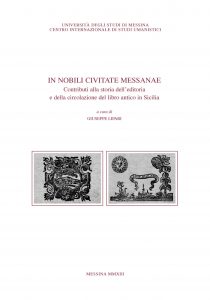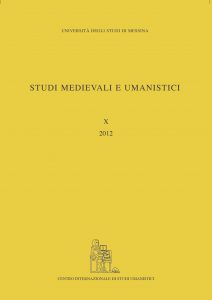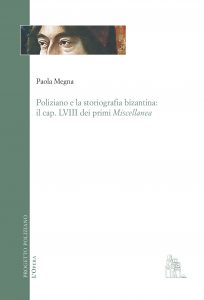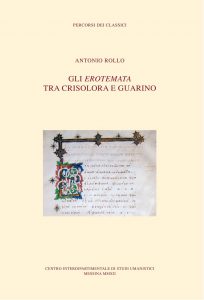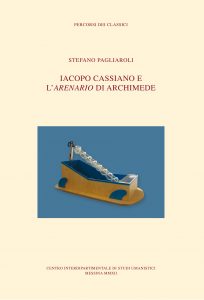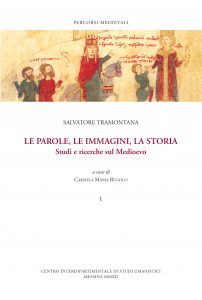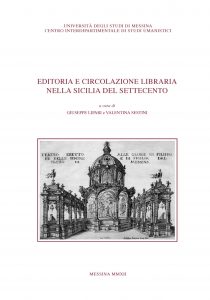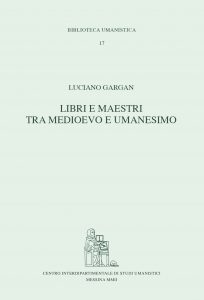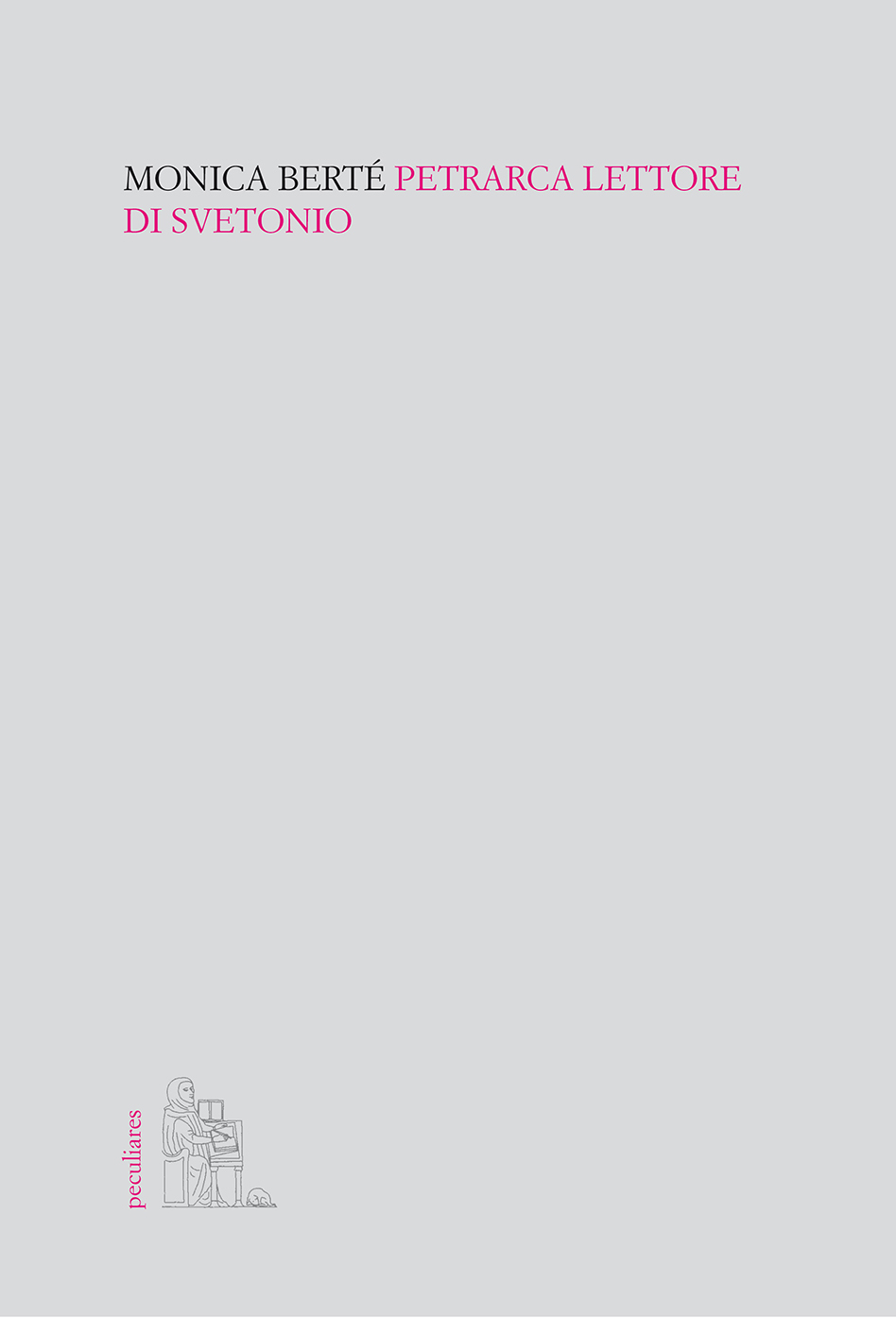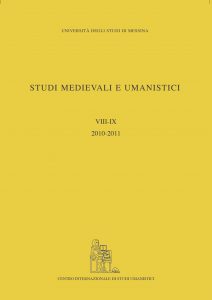
VIII-IX (2010-2011)
Messina, Centro Internazionale di Studi Umanistici, 2010-11, 559 pp., tavv. XXIV; 25 cm.
ISSN 2035-3774
€ 120
INDICE GENERALE
Xavier van Binnebeke, Payne & Foss, Sir Thomas Phillipps and the Manuscripts of San Marco
Giovanni Cascio, Sine nomine extravaganti
Daniela Gionta, Per la storia della silloge epigrafica attribuita a Poggio Bracciolini
Aldo Onorato, Tra Seneca e Mussato: fortuna, potere e morte in una tragedia latina del Quattrocento
Stefano Rocchi – Leofranc Holford-Strevens, ‘Graeca’ e ‘latina’ stravaganti dalla praefatio alle Notti Attiche nella princeps e nella vulgata
Alessandro Daneloni, Un Galeno studiato da Angelo Poliziano
SEMINARIO POLIZIANEO PER SILVIA RIZZO
Silvia Rizzo, Un’idea per le Stanze
Irene Iocca, Su testo e lingua delle Stanze
Gianna D’Alessio, Misc. II 10. Aetia
Giovanni Vassallo, Misc. II 47. Cresphontes
Elisa Saltetto, Misc. II 53. Universale
Laura Refe, Le due redazioni dell’epistola di Michele Acciari al Poliziano
Antonino Antonazzo, I codici di dedica del volgarizzamento pliniano
di Cristoforo Landino: una revisione autografa
TESSERE
G. Cascio, Un’interpunzione erronea in Petrarca, Fam. XII 6, 2
A. Rollo, Chrysolorina I-II
A. Rollo, Un lessico a torto attribuito alla biblioteca di Filelfo
A. Onorato, Un’inedita praelectio di Niccolò Volpe alle Bucoliche di Virgilio
S. Martinelli Tempesta, Nuovi manoscritti copiati da Giorgio Trivizia
A. Daneloni, Un nuovo libro della biblioteca di Bartolomeo Fonzio
A. Antonazzo, Per Cristoforo Landino
C. Mussini, Il punto su Pier Matteo Uberti
S. Pagliaroli, Il Demostene aldino di Christophe de Longueil
S. Pagliaroli, Un ignoto postillato di Scipione Carteromaco
Indice delle tavole
Indice dei manoscritti e delle fonti d’archivio
Indice dei nomi
ABSTRACT
XAVIER VAN BINNEBEKE, Payne & Foss, Sir Thomas Phillipps and the Manuscripts of San Marco
The present article focuses on a book list which currently belongs to the collection of Martin Schøyen. It was sent by the London booksellers Payne & Foss to Sir Thomas Phillipps in 1833 and describes fifteen manuscripts in Greek and Latin from the library of the Dominican convent of San Marco in Florence. All the volumes are still extant in various European and North-American libraries: whilst several have been known for some time, some have hitherto escaped the attention of the researchers of the San Marco collection. This study discusses in detail the palaeographical, codicological, and textual features of these books, thus enhancing our understanding of their provenance history, their use and early readership. It also aims to illustrate how a thorough description and discussion of manuscripts from the San Marco library can pave the way for new and important research perspectives in the field of medieval and (early) modern European book culture.
GIOVANNI CASCIO, Sine nomine extravaganti
This article deals with the transmission of the extravagantes epistles of Petrarch’s Liber sine nomine. As a result of an overall reconsideration of the manuscript tradition of the antipapal letters, conducted in order to produce a new critical edition, it emerged that six letters had had an autonomous circulation, independently from the rest of the collection. Among these, however, only four seem to have transmitted an earlier stage of the text. Particular attention has been paid to Sine nom. 1: in a manuscript unknown to the previous editor (Wolfenbüttel, Herzog August Bibliothek, 45.6 Aug. fol., f. 45rv = Wo1), the letter has been transmitted with significant textual and structural features. On the grounds of these features, it has been possible to recognise with certainty the recipient of the letter as Philippe de Cabassole, bishop of Cavaillon, and to determine its date as may 1342.
DANIELA GIONTA, Per la storia della silloge epigrafica attribuita a Poggio Bracciolini
Since the preliminary studies of Giovan Battista de Rossi, which later merged into CIL VI, no one has dealt with the two manuscript witnesses of the so-called Poggio’s epigraphic sylloge: Biblioteca Apostolica Vaticana, Vat. lat. 9152 and Roma, Biblioteca Angelica, ms. lat. 430. Up until now they have been considered as late copies. This study represents the first detailed survey of both codices, their copyists and their stratified inner structure. They have turned out to be manuscripts written in the second half of Quattrocento – that is, much closer to the time of the collection’s composition – in two crucial centres for antiquarian research: Rome and Padua.
ALDO ONORATO, Tra Seneca e Mussato: fortuna, potere e morte in una tragedia latina del Quattrocento
This paper focuses on the influence exerted by Seneca’s tragedies and Albertino Mussato’s Ecerinis on Laudivio Zacchia’s De captivitate ducis Jacobi tragoedia. The latter is a Latin tragedy from the 15th century, inspired by the capture and murder of the great captain Jacopo Piccinino, who was a victim of the intrigues planned by Francesco Sforza and Ferrante of Aragona. The study shows that in Laudivio’s play, some features (i.e. the treatment of the theme of Fortune) derive from the above-mentioned models, whilst other elements (i.e. the portrait of some powerful men such as Borso of Este) are original.
STEFANO ROCCHI – LEOFRANC HOLFORD-STREVENS, ‘Graeca’ e ‘latina’ stravaganti dalla praefatio alle Notti Attiche nella princeps e nella vulgata
Aulus Gellius, in the preface to his Attic Nights, lists at length ingenious miscellany titles in Greek and Latin, with which he professes not to compete. Those in Greek are preserved only in two medieval manuscripts, being represented in the later copies by .G. or the like; but in the editio princeps by Giovanni Andrea Bussi (Rome, 1469) most of the gaps are inauthentically filled with titles that the two authors show to have come from other writers – Jerome, the elder Pliny, Diogenes Laertius, and possibly Cicero – edited by Bussi and/or published by his printers Arnold Pannartz and Conrad Sweynheym. Further titles were supplied by J. B. Egnatius (Cipelli) in the Aldine edition of 1515; these too are traced to their likely sources. Two appendices present respectively remarks on the preface and a new edition of the passage in question by Holford-Strevens alone.
ALESSANDRO DANELONI, Un Galeno studiato da Angelo Poliziano
The manuscript Laur. Plut. 74, 3 is one of the most important witnesses of many works of Galen. Copied probably in Constantinople between the XII and the beginning of the XIII century, it arrived in Italy, in Florence, in 1492, brought there by Giano Lascari, who was an emissary of Lorenzo de’ Medici in various areas of Italy and Greece, for the acquisition of new codes and new authors of Hellenic culture. In the private library of the Medici, the precious codex of Galen was soon noted by Angelo Poliziano, who performed a preliminary survey of this volume, by writing in his hand the index of all the Greek writings, now visible to the f. Vv of Laur. Plut. 74, 3. The untimely death of the Florentine humanist, in September 1494, prevented him from carrying out additional, more thoughtful and thorough reading of this important manuscript.
SILVIA RIZZO, Un’idea per le Stanze
Politian wrote the Stanze to celebrate the victory of Giuliano de’ Medici in the joust of January, 29th, 1475. In the second book, verses 12, 4-8 and 14, 2-8 are absent from all the manuscripts and are preserved only by the editio princeps: they include an allusion to another joust where Lorenzo de’ Medici would have won the first prize. These verses were regarded as spurious and the obscure allusion to a second joust added a motive for considering them an interpolation. Rossella Bessi solved the problem of the second joust drawing attention to documents mentioning a planned joust on February, 6th, 1475, only a few days after the joust won by Giuliano. One of these documents – a letter by Rodolfo Gonzaga to his mother Barbara – informs us that the fight in the planned tournament should have taken place between two groups, the defenders and the accusers of Love, and that Lorenzo would have been fighting in the first group and Giuliano in the second. I argue that the coincidence between this planned tournament in which Lorenzo was defensor and Giuliano accuser of Love, and the fact that in Politian’s poem Giuliano is depicted as the enemy of Love and Lorenzo as his champion, cannot be serendipitous. In my opinion, this is another of several links, which can be detected between the complex symbolical apparatus of of the actual Medicean celebrations and the themes of the poem, all the more so that Politian had in all probability some part in the formulation of the iconographic and symbolic programme of the joust.
IRENE IOCCA, Su testo e lingua delle Stanze
This paper, devoted to Angelo Poliziano’s main poema (Stanze per la giostra di Giuliano de’ Medici), is divided into three parts: the first one suggests a new arrangement for the manuscript tradition and a new stemma codicum based on a complete collatio of the surviving copies. The second part focuses on the Stanze’s orthography, and highlights the Bolognese edition of 1494 in this respect. The last part offers a short specimen of a new edition.
GIANNA D’ALESSIO, Misc. II 10. Aetia
The purpose of this paper is to explain Politian’s philological studies, to be found in a chapter (10. Aetia) of Miscellaneorum Centuria Secunda. In the first part, this paper shows how Politian restores the title and some fragments of one of Callimaco’s lost works, the Aetia, commenting on Martial’s corrupted line and using new Greek manuscripts, brought by Lascaris to Florence. the second part of the paper focuses on the reception of the chapter in the sixteenth century.
GIOVANNI VASSALLO, Misc. II 47. Cresphontes
The A. examines Angelo Poliziano’s Miscellanea II. 47 focussing on two topics: (1) the correction of the widespread title Ctesiphontes, a lost euripidean tragedy, into cresphontes on the grounds of a vetustior codex and some fragmentary sources; (2) the problem of the authorship of Rhetorica ad Herennium: the surviving autographic material shows the uneven path that led Poliziano to delete the name of Cicero and prefer an anonymous formulation.
ELISA SALTETTO, Misc. II 53. Universale
In chapter 53 of his Miscellaneorum centuria secunda, Politian focuses on identifying the most appropriate definition and interpretation of the concept of ‘universal’ (τὸ καθόλου) within the context of Aristotelian logic and gnoseology. Through a deep analysis of the composition and translation methods of the author, this paper aims to provide a reconstruction of the literary sources available in his time, and of the cultural environment in which he might have developed his theory. The study means to show the modernity of Politian’s interpretation compared with the Medieval ones. Nevertheless, his debt to Scholasticism is also emphasized, most especially with regard to the use of philosophical terms.
LAURA REFE, Le due redazioni dell’epistola di Michele Acciari al Poliziano
Michele Acciari da Uzzano, pupil of Angelo Poliziano at the Studium Florentiae, appears as a correspondent in the editio princeps of Poliziano’s Omnia Opera, as the author of letter XXIV of book XII. The collation of the letter in the first edition, together with the manuscript of a collection of letters by Acciari (Biblioteca Nazionale of Florence, Filza Rinuccini 17 inserto 7), shows that he was in contact with Alessandro Sarti, curator of the letters of Poliziano after his death, and helped to edit the letter with a view to its inclusion in the editio princeps.
ANTONINO ANTONAZZO, I codici di dedica del volgarizzamento pliniano di Cristoforo Landino: una revisione autografa
The A. examines the dedicatory manuscripts (San Lorenzo de El Escorial, Real Biblioteca del Monasterio, h. I. 2-3) of Cristoforo Landino’s Italian translation of Pliny the Elder’s Naturalis Historia. Written in Florence in the first half of the 1470s, the ms reveals for the first time a remarkable series of emendations (both marginal and interlinear, but also embedded in the text itself and written over erasures). The emendations have been identified as having been written in Landino’s hand on the grounds of a wide-ranging palaeographical and philological analysis (carried out through a comparison with the editio princeps of the translation [venice 1476]), and bearing in mind the most important dedicatory manuscripts which emerged from Landino’s study. Thus, this study highlights Landino’s work of revision on significant copies prior to their release.
G. CASCIO, Un’interpunzione erronea in Petrarca, Fam. XII 6, 2
This contribution offers a slight correction to the erroneous punctuation of a passage from the Fam. XII 6 addressed by Francesco Petrarca to Philippe de Cabassole, bishop of Cavaillon. On the basis of the analysis of the Petrarchan usus, it has been possible to eliminate a comma inserted by Vittorio Rossi, the national editor of the Familiares, between ruris and tui: the expression ruris tui, in fact, represented the particular way in which Petrarch, when communicating with Philippe, referred to Valchiusa, which, being in the vicinity of Cavaillon, fell within the ecclesiastical jurisdiction of Cabassole.
A. ROLLO, Chrysolorina I-II
This contribution shows that, sometimes, it is difficult to identify Chrysoloras’ Erotemata because of their reworked version, and it proposes some observations on the text of the critical edition of the grammar.
A. ROLLO, Un lessico a torto attribuito alla biblioteca di Filelfo
On the grounds of a new reading of Philelphus’ letter in Laur. Conv. Soppr. 181, the provenance of the Greek-Latin lexicon in this MS from his library is questioned.
A. ONORATO, Un’inedita praelectio di Niccolò Volpe alle Bucoliche di Virgilio
The ms. Clm. 5369 (München, Bayerische Staatsbibliothek) transmits the praelectio to Virgil’s Eclogues held by a young Niccolò Volpe, still a student perhaps in Venice or Padua, just before he started to work for Pietro Donato (Donà), bishop of Padua, in 1432. It is an unpublished and rare text that proves the prominent role given to the most gifted pupils by the teachers of the school of Veneto in the first half of the 15th century. The praelectio is here critically edited and equipped with an apparatus of the literary sources and a commentary.
S. MARTINELLI TEMPESTA, Nuovi manoscritti copiati da Giorgio Trivizia
The A. proposes a new codicological description of six new manuscripts by the hand of the Cretan priest Georgius Tribizias and discusses their role in the transmission of Greek classical and Byzantine texts in fifteenth-century Italy: Ambr. G 72 sup. (Thucydides), Laur. 59, 4 (Isocrates and Demetrius Cydonius), Ambr. C 87 sup. and Laur. 59, 25 (Demosthenes), Ambr. T 122 sup. (Philostratus), and Ambr. 162 sup. (Nicander). Moreover, the A. analyses the fifteenth-century restoration of the Demosthenes Ambr. Q 43 sup. (XIV c.).
A. DANELONI, Un nuovo libro della biblioteca di Bartolomeo Fonzio
Here is presented a manuscript, which has been neglected up until now, and whichwas owned by the Florentine humanist Bartolomeo Fonzio (1447-1513) and now is the G XI 89 of the Biblioteca Comunale degli Intronati of Siena. The manuscript contains the Latin version of Aristotle’s De coelo, realized by Giovanni Argiropulo. Copied between the end of the sixties and the seventies, this codex presents many of Fonzio’s autographic marginal notes, evidence of a very careful and interested study, which can be dated around the beginning of the XVI Century.
A. ANTONAZZO, Per Cristoforo Landino
This contribution, concerning Cristoforo Landino, is divided into two parts. In the first part, the paper attributes the handwriting of the dedicatory manuscript of Landino’s De Anima (Urb. lat. 1370) to the copyist Niccolò Riccio, who – it is argued – was favoured by the Florentine humanist for the most significant copies of his literary work. The second part of the paper critically assesses Landino’s Greek handwriting: on the grounds of some of his lesser examined notes, new Greek autographic fragments are assigned to him, thus shedding new light onto the Italian humanist’s relationship with the Greek language.
C. MUSSINI, Il punto su Pier matteo Uberti
Pier Matteo Uberti, one of Politian’s students and assistants in the 1490s, helped him in some of his most important philological efforts: the collation of Iustinian’s Digestus and the reconstruction of medical and scientific Latin termini. This paper will offer some new information about Uberti: he attended Politian’s lecture about Plinius in 1489-90, annotated an incunable of the Naturalis historia with interesting philological marginalia, and participated actively in the collation of the Digestus also by drawing up lists of Iuris consulti now in the Clm 755.
S. PAGLIAROLI, Il Demostene aldino di Christophe de Longueil
This paper illustrates the discovery of a copy of the Aldine Demosthenes of the year 1504 annotated by the humanist Christophe de Longueil (the frontispice displays his ownership note and coat of arms).
S. PAGLIAROLI, Un ignoto postillato di Scipione Carteromaco
This paper illustrates the discovery of a composite volume – owned by Scipione Forteguerri (Carteromachus), who copiously annotated it. The volume was later included in the list of Fulvio Orsini’s books – containing, bound together, the aldines of Pollux and of Stephanus Byzantinus (both issued in the year 1502) and a new Greek manuscript of the epistle of Petosiris to Nechepso.
